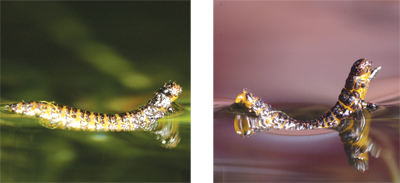Baby Beetles Inspire Pitt Researchers to Build “Mini Boat” Powered by Surface Tension


A wriggling beetle larva might repulse the average person, but Pitt professor Sung Kwon Cho admired the way they get around on water. Certain beetle babies glide across water by harnessing the energy of surface tension, or the natural pull of water on a floating object.
Cho, a professor of mechanical engineering and materials science in the Swanson School of Engineering, designed a propulsion system that strips away paddles, sails, and motors and travels, larva-style, by manipulating surface tension. Cho will present his findings today at the Institute of Electrical and Electronics Engineers’ 2009 Micro Electro Mechanical Systems (MEMS) conference in Sorrento, Italy.
In Cho’s experiments, an electrode attached to a “mini boat” destabilized the surrounding surface tension with an electric pulse and caused the craft to move via the surface’s natural pull.
Cho envisioned the system after colleagues at the Massachusetts Institute of Technology published research in Nature in 2005 that described the way beetle larvae move on water, he said. Like any floating object, a larva resting in the water causes the surface tension to pull equally on both sides. To move forward, the larva bends its back downward to change the tension direction behind it. The forward tension then pulls the larva through the water.
Cho and Pitt engineering doctoral students Sang Kug Chung and Kyungjoo Ryu substituted the larva’s back bending with the electric pulse.
In video of their experiments, a 2-centimeter-long “mini boat” skims across a tub of water with only slight disturbance. An electrode attached to the rear of the boat is emitting a surge that changes the rear surface tension direction and propels the boat forward at roughly 4 millimeters per second. A second electrode attached to the boat’s front side served as a rudder and additional video shows the boat spinning with like effortlessness under its power.
Cho sees this method of propulsion as an efficient and low-maintenance mechanism for small robots and boats that monitor water quality in oceans, reservoirs, and other bodies of water, he said. These devices are typically propeller-driven, which can consume a lot of energy. The technique Cho developed has no moving parts and the low-energy electrode that emits the pulse could be powered by batteries, radio waves, or solar power, he added.
An abstract of Cho’s mechanism is available on Pitt’s Web site at www.pitt.edu/news2009/Cho.pdf.
Footage of the boat is available at www.pitt.edu/news2009/curving_top_cho.wmv. A film of the rudder capability can be viewed at www.pitt.edu/news2009/rotation_side_cho.wmv.
More information on MEMS 2009 is available at the conference Web site at www.mems2009.org
Footage of the boat is available at www.pitt.edu/news2009/curving_top_cho.wmv. A film of the rudder capability can be viewed at www.pitt.edu/news2009/rotation_side_cho.wmv.
More information on MEMS 2009 is available at the conference Web site at www.mems2009.org
Other Stories From This Issue
On the Freedom Road

Follow a group of Pitt students on the Returning to the Roots of Civil Rights bus tour, a nine-day, 2,300-mile journey crisscrossing five states.
Day 1: The Awakening
Day 2: Deep Impressions
Day 3: Music, Montgomery, and More
Day 4: Looking Back, Looking Forward
Day 5: Learning to Remember
Day 6: The Mountaintop
Day 7: Slavery and Beyond
Day 8: Lessons to Bring Home
Day 9: Final Lessons

